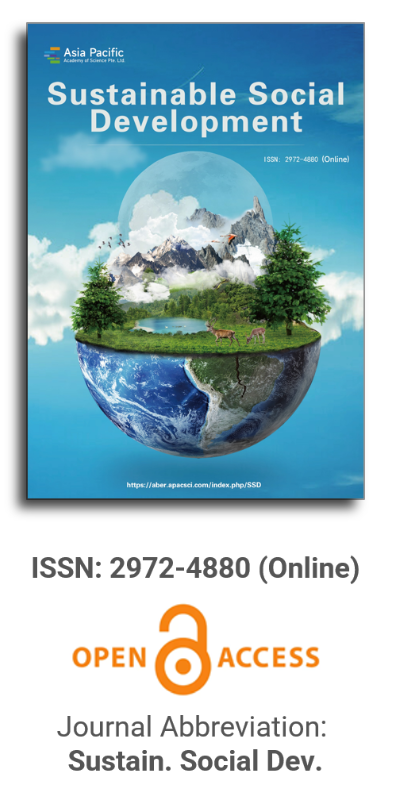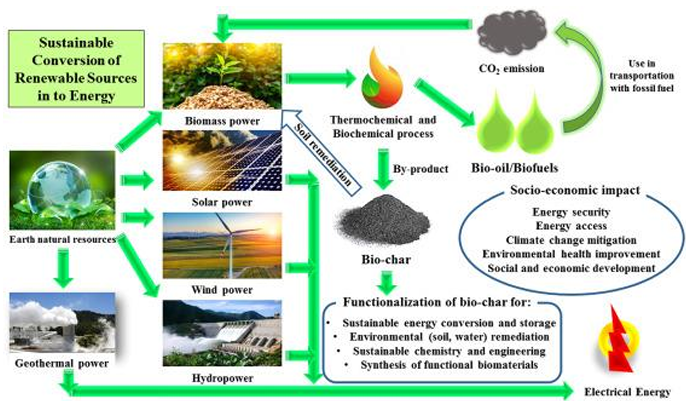
Publication Frequency
Bi-monthly (since 2024)
Journal Articles
Search
Search scope
Journal Center
Asia Pacific Academy of Science Pte. Ltd. (APACSCI) specializes in international journal publishing. APACSCI adopts the open access publishing model and provides an important communication bridge for academic groups whose interest fields include engineering, technology, medicine, computer, mathematics, agriculture and forestry, and environment.
Volume Arrangement
2025
Featured Articles

Coordinated actions to protect biodiversity, incorporate renewable energy, and implement climate action are needed for sustainable development to be achieved in the context of global challenges like climate change, ecosystem destruction, and resource depletion. Climate action seeks to reduce the negative impact and strengthen the adaptive capacity of natural and human society. Climate action includes both adaptation and mitigation strategies. The transition to renewable power sources is of utmost importance to climate action because it helps to slow environmental degradation, curtail fossil fuel dependence, and significantly diminish greenhouse gas emissions. The adoption of renewable energy, such as solar, wind, and hydropower, is more environmentally friendly than conventional energy sources, but it may also pose potential risks towards biodiversity, so measures should be taken in planning to avoid negative environmental impacts. It is crucial to protect biodiversity around the world because it plays an important role in the delivery of ecosystem services such as soil fertility, pollination, water purification, and the sequestration of carbon that are vital to people’s existence. In addition, strong ecosystems reduce the severity of climate change impacts, such as storms, droughts, and flooding. However, there may be trade-offs when striving for the increase of renewable energy and biodiversity conservation. Renewable energy development should always be complemented with biodiversity protection. This approach preserves the environmentally delicate ecosystems that are crucial to achieving climate action targets. The combination of climate action, renewable energy, and the need for biodiversity makes it possible to reap many benefits. These include stronger ecosystems and better human health, as well as economic growth and job creation. One example of such a nature-based solution is agrovoltaics, which combines solar energy production and farming. Restoring ecosystems, like forests or wetlands, can also greatly enhance carbon sequestration, reduce global warming, and protect endangered wildlife. This strategy aligns with international initiatives such as the United Nations Sustainable Development Goals (UN SDGs), specifically SDGs 7, 13, and 15. It serves as a building block towards a more sustainable future. Despite the clear possibilities of synergy, there are still barriers that must be tackled. Policy fragmentation, resource competition, and lack of inter-sector cooperation are some of the challenges that inhibit effective integration. Therefore, equitable governance and the adoption of nature-based techniques are essential.
Exploring the link between energy resources and global biodiversity
Article ID: 3245
Vol 3, Issue 2, 2025
DOI: https://doi.org/10.54517/ssd3245
Vol 3, Issue 2, 2025
Received: 24 January 2025; Accepted: 28 February 2025; Available online: 6 March 2025; Issue release: 30 April 2025
Download PDF
Abstract
The availability of energy resources and their relationship with global biodiversity are critical concerns that demand urgent attention, especially given the world’s rising energy demands. This review paper examines the impacts of both renewable and non-renewable energy sources on biodiversity across different ecosystems. The extraction and use of fossil fuels—coal, oil, and natural gas—have led to severe pollution, habitat destruction, and climate change, threatening countless species and ecosystems. The processing and consumption of these non-renewable resources continue to accelerate biodiversity loss. While renewable energy sources—such as solar, wind, bioenergy, and hydropower—offer a pathway to reducing greenhouse gas emissions, they also pose biodiversity challenges. Large-scale solar farms alter land use, causing habitat fragmentation. Wind farms, while crucial for clean energy, threaten bird and bat populations. Hydropower projects disrupt river ecosystems, affecting aquatic species’ migration patterns. Similarly, bioenergy production often relies on extensive monoculture farming, leading to deforestation, agrobiodiversity loss, and competition with food crops. This paper explores mitigation strategies, emphasizing ecological offsets and habitat restoration as key conservation tools. These approaches align with global frameworks such as the United Nations Sustainable Development Goals (SDGs), ensuring that energy policies integrate biodiversity protection. The review highlights the importance of balancing energy expansion with environmental sustainability through strategic policymaking. A region-specific approach is essential, given the varying energy needs and ecological sensitivities across countries. Overreliance on energy-intensive technologies in some regions exacerbates environmental degradation, necessitating countermeasures to prevent resource overexploitation. By incorporating biodiversity-conscious energy strategies into decision-making, it is possible to achieve a sustainable balance between energy production and conservation. This analysis underscores the need for globally coordinated yet locally adaptive policies to ensure that the transition to renewable energy does not come at the expense of biodiversity.
Keywords
energy resources; global biodiversity; renewable energy; environmental impact; biodiversity conservation
References
- Perera F. Pollution from Fossil-Fuel Combustion is the Leading Environmental Threat to Global Pediatric Health and Equity: Solutions Exist. International Journal of Environmental Research and Public Health. 2017; 15(1): 16. doi: 10.3390/ijerph15010016
- Foley JA, DeFries R, Asner GP, et al. Global Consequences of Land Use. Science. 2005; 309(5734): 570-574. doi: 10.1126/science.1111772
- Rahman A, Farrok O, Haque MM. Environmental impact of renewable energy source based electrical power plants: Solar, wind, hydroelectric, biomass, geothermal, tidal, ocean, and osmotic. Renewable and Sustainable Energy Reviews. 2022; 161: 112279. doi: 10.1016/j.rser.2022.112279
- Gasparatos A, Doll CNH, Esteban M, et al. Renewable energy and biodiversity: Implications for transitioning to a Green Economy. Renewable and Sustainable Energy Reviews. 2017; 70: 161-184. doi: 10.1016/j.rser.2016.08.030
- Hernandez RR, Easter SB, Murphy-Mariscal ML, et al. Environmental impacts of utility-scale solar energy. Renewable and Sustainable Energy Reviews. 2014; 29: 766-779. doi: 10.1016/j.rser.2013.08.041
- Popp J, Lakner Z, Harangi-Rákos M, et al. The effect of bioenergy expansion: Food, energy, and environment. Renewable and Sustainable Energy Reviews. 2014; 32: 559-578. doi: 10.1016/j.rser.2014.01.056
- Pflieger G. COP27: One step on loss and damage for the most vulnerable countries, no step for the fight against climate change. Males J, ed. PLOS Climate. 2023; 2(1): e0000136. doi: 10.1371/journal.pclm.0000136
- McCay SD, Lacher TE. National level use of International Union for Conservation of Nature knowledge products in American National Biodiversity Strategies and Action Plans and National Reports to the Convention on Biological Diversity. Conservation Science and Practice. 2021; 3(5). doi: 10.1111/csp2.350
- Hauschild MZ, Kara S, Røpke I. Absolute sustainability: Challenges to life cycle engineering. CIRP Annals. 2020; 69(2): 533-553. doi: 10.1016/j.cirp.2020.05.004
- Pandit J, Sharma AK. A comprehensive review of climate change’s imprint on ecosystems. Journal of Water and Climate Change. 2023; 14(11): 4273–4284. doi: 10.2166/wcc.2023.476
- Bauerek A. The environmental impact of coal mining and extraction. Journal of Environmental Hazards. 2024; 8.
- Gasparotto J, Da Boit Martinello K. Coal as an energy source and its impacts on human health. Energy Geoscience. 2021; 2(2): 113-120. doi: 10.1016/j.engeos.2020.07.003
- Harfoot MBJ, Tittensor DP, Knight S, et al. Present and future biodiversity risks from fossil fuel exploitation. Conservation Letters. 2018; 11(4). doi: 10.1111/conl.12448
- Biswas G, Sengupta A, Alfaisal FM, et al. Evaluating the effects of landscape fragmentation on ecosystem services: A three-decade perspective. Ecological Informatics. 2023; 77: 102283. doi: 10.1016/j.ecoinf.2023.102283
- Mishra A, Swamy SL, Thakur TK, et al. Impact of coal mining on land use changes, deforestation, biomass, and C losses in Central India: Implications for offsetting CO2 emissions. Land Degradation & Development. 2022; 33(18): 3731-3747. doi: 10.1002/ldr.4419
- Dao PU, Heuzard AG, Le TXH, et al. The impacts of climate change on groundwater quality: A review. Science of The Total Environment. 2024; 912: 169241. doi: 10.1016/j.scitotenv.2023.169241
- Akcil A, Koldas S. Acid Mine Drainage (AMD): causes, treatment and case studies. Journal of Cleaner Production. 2006; 14(12-13): 1139-1145. doi: 10.1016/j.jclepro.2004.09.006
- Jones NF, Pejchar L, Kiesecker JM. The Energy Footprint: How Oil, Natural Gas, and Wind Energy Affect Land for Biodiversity and the Flow of Ecosystem Services. BioScience. 2015; 65(3): 290-301. doi: 10.1093/biosci/biu224
- Pan A, Xu S, Zaidi SAH. Environmental impact of energy imports: Natural resources income and natural gas production profitability in the Asia-Pacific Economic Cooperation Countries. Geoscience Frontiers. 2024; 15(2): 101756. doi: 10.1016/j.gsf.2023.101756
- Meng Q. The impacts of fracking on the environment: A total environmental study paradigm. Science of The Total Environment. 2017; 580: 953-957. doi: 10.1016/j.scitotenv.2016.12.045
- Akpan EE. Environmental Consequences of Oil Spills on Marine Habitats and the Mitigating Measures—The Niger Delta Perspective. Journal of Geoscience and Environment Protection. 2022; 10(06): 191-203. doi: 10.4236/gep.2022.106012
- Shivanna KR. Climate change and its impact on biodiversity and human welfare. Proceedings of the Indian National Science Academy. 2022; 88(2): 160-171. doi: 10.1007/s43538-022-00073-6
- Mar KA, Unger C, Walderdorff L, et al. Beyond CO2 equivalence: The impacts of methane on climate, ecosystems, and health. Environmental Science & Policy. 2022; 134: 127-136. doi: 10.1016/j.envsci.2022.03.027
- Henle K, Gawel E, Ring I, et al. Promoting nuclear energy to sustain biodiversity conservation in the face of climate change: response to Brook and Bradshaw 2015. Conservation Biology. 2016; 30(3): 663-665. doi: 10.1111/cobi.12691
- Brook BW, Bradshaw CJA. Key role for nuclear energy in global biodiversity conservation. Conservation Biology. 2014; 29(3): 702-712. doi: 10.1111/cobi.12433
- Agboola C. The effects of thermal pollution on aquatic ecosystems. Journal of Industrial Pollution Control. 2023; 39.
- Kati V, Kassara C, Vrontisi Z, et al. The biodiversity-wind energy-land use nexus in a global biodiversity hotspot. Science of The Total Environment. 2021; 768: 144471. doi: 10.1016/j.scitotenv.2020.144471
- Alsaleh M, Abdulwakil MM, Abdul-Rahim AS. Land-Use Change Impacts from Sustainable Hydropower Production in EU28 Region: An Empirical Analysis. Sustainability. 2021; 13(9): 4599. doi: 10.3390/su13094599
- Tinsley E, Froidevaux JSP, Zsebők S, et al. Renewable energies and biodiversity: Impact of ground‐mounted solar photovoltaic sites on bat activity. Journal of Applied Ecology. 2023; 60(9): 1752-1762. doi: 10.1111/1365-2664.14474
- Ezzaeri K, Fatnassi H, Bouharroud R, et al. The effect of photovoltaic panels on the microclimate and on the tomato production under photovoltaic canarian greenhouses. Solar Energy. 2018; 173: 1126-1134. doi: 10.1016/j.solener.2018.08.043
- Tesfahunegny W, Datiko D, Wale M, et al. Impact of wind energy development on birds and bats: the case of Adama wind farm, Central Ethiopia. The Journal of Basic and Applied Zoology. 2020; 81(1). doi: 10.1186/s41936-020-00171-1
- Tudge SJ, Purvis A, De Palma A. The impacts of biofuel crops on local biodiversity: a global synthesis. Biodiversity Conservation. 2021; 30: 2863–2883. doi: 10.1007/s10531-021-02232-5
- Anifowose B, Odubela M. Methane emissions from oil and gas transport facilities—exploring innovative ways to mitigate environmental consequences. Journal of Cleaner Production. 2015; 92: 121-133. doi: 10.1016/j.jclepro.2014.12.066
- Ojija F, Nicholaus R. Impact of Climate Change on Water Resources and its Implications on Biodiversity: A Review. East African Journal of Environment and Natural Resources. 2023; 6(1): 15-27. doi: 10.37284/eajenr.6.1.1063
- Shindell D, Kuylenstierna JCI, Vignati E, et al. Simultaneously Mitigating Near-Term Climate Change and Improving Human Health and Food Security. Science. 2012; 335(6065): 183-189. doi: 10.1126/science.1210026
- Moghimi Dehkordi M, Pournuroz Nodeh Z, Soleimani Dehkordi K, et al. Soil, air, and water pollution from mining and industrial activities: Sources of pollution, environmental impacts, and prevention and control methods. Results in Engineering. 2024; 23: 102729. doi: 10.1016/j.rineng.2024.102729
- Doney SC, Fabry VJ, Feely RA, et al. Ocean Acidification: The Other CO2 Problem. Annual Review of Marine Science. 2009; 1(1): 169-192. doi: 10.1146/annurev.marine.010908.163834
- Kondaveeti S, Mohanakrishna G, Lee JK, et al. Methane as a Substrate for Energy Generation Using Microbial Fuel Cells. Indian Journal of Microbiology. 2018; 59(1): 121-124. doi: 10.1007/s12088-018-0765-6
- Sala OE, Stuart Chapin F, III, et al. Global Biodiversity Scenarios for the Year 2100. Science. 2000; 287(5459): 1770-1774. doi: 10.1126/science.287.5459.1770
- Bennun J, van Bochove J, Ng C, et al. Mitigating biodiversity impacts associated with solar and wind energy development: Guidelines for Project Developers. IUCN & The Biodiversity Consultancy. 2021. doi: 10.2305/IUCN.CH.2021.04.en
- Kaygusuz K. Wind Power for a Clean and Sustainable Energy Future. Energy Sources, Part B: Economics, Planning, and Policy. 2009; 4(1): 122-133. doi: 10.1080/15567240701620390
- Hernandez RR, Hoffacker MK, Murphy-Mariscal ML, et al. Solar energy development impacts on land cover change and protected areas. Proceedings of the National Academy of Sciences. 2015; 112(44): 13579-13584. doi: 10.1073/pnas.1517656112
- Wang F, Harindintwali JD, Wei K, et al. Climate change: Strategies for mitigation and adaptation. The Innovation Geoscience. 2023; 1(1): 100015. doi: 10.59717/j.xinn-geo.2023.100015
- Long Y, Chen Y, Xu C, et al. The role of global installed wind energy in mitigating CO2 emission and temperature rising. Journal of Cleaner Production. 2023; 423: 138778. doi: 10.1016/j.jclepro.2023.138778
- Tolvanen A, Routavaara H, Jokikokko M, et al. How far are birds, bats, and terrestrial mammals displaced from onshore wind power development?—A systematic review. Biological Conservation. 2023; 288: 110382. doi: 10.1016/j.biocon.2023.110382
- Schöll EM, Nopp-Mayr U. Impact of wind power plants on mammalian and avian wildlife species in shrub- and woodlands. Biological Conservation. 2021; 256: 109037. doi: 10.1016/j.biocon.2021.109037
- Thaxter CB, Buchanan GM, Carr J, et al. Bird and bat species’ global vulnerability to collision mortality at wind farms revealed through a trait-based assessment. Proceedings of the Royal Society B: Biological Sciences. 2017; 284(1862): 20170829. doi: 10.1098/rspb.2017.0829
- Erbe C, Dent ML, Gannon WL, et al. The effects of noise on animals. In: Erbe C, Thomas JA (editors). Exploring animal behavior through sound, 1st ed. Springer, Cham; 2022. pp. 459–506.
- Gartman V, Bulling L, Dahmen M, et al. Mitigation Measures for Wildlife in Wind Energy Development, Consolidating the State of Knowledge—Part 2: Operation, Decommissioning. Journal of Environmental Assessment Policy and Management. 2016; 18(03): 1650014. doi: 10.1142/s1464333216500149
- Tallis H, Kennedy CM, Ruckelshaus M, et al. Mitigation for one & all: An integrated framework for mitigation of development impacts on biodiversity and ecosystem services. Environmental Impact Assessment Review. 2015; 55: 21-34. doi: 10.1016/j.eiar.2015.06.005
- Jolli V. Hydro Power Development and Its Impacts on the Habitats and Diversity of Montane Birds of Western Himalayas. Vestnik Zoologii. 2017; 51(4): 311-324. doi: 10.1515/vzoo-2017-0036
- Bunea F, Ciocan GD, Oprina G, et al. Hydropower Impact on Water Quality. Environmental Engineering and Management Journal. 2010; 9(11): 1459-1464. doi: 10.30638/eemj.2010.195
- Price SJ, Muncy BL, Bonner SJ, et al. Effects of mountaintop removal mining and valley filling on the occupancy and abundance of stream salamanders. Bellard C, ed. Journal of Applied Ecology. 2015; 53(2): 459-468. doi: 10.1111/1365-2664.12585
- The Open Wounds of Coal Mining in Colombia: Impacts of the Cerrejón coal mine on the environment and population in the La Guajira department. Available online: https://kolko.net/wp-content/uploads/2017/08/La-Guajira-eng-Vers-print.compressed.pdf (accessed on 20 January 2025).
- Green Peace. Research Briefing: Impacts of the proposed Carmichael Coal Mine Project on the Black-throated Finch (Southern). Available online: https://www.banktrack.org/download/impacts_of_the_proposed_carmichael_coal_mine_project_on_the_black_throated_finch/blackthroated_finch_gp_fact_sheet_2014.pdf (accessed on 20 January 2025).
- Buburuz M, Borlea S, Vintilă M, et al. Pressures, threats and impacts on life in the Black Sea. Available online: https://www.greenpeace.org/static/planet4-romania-stateless/2024/05/5bacf577-02_pressures-threats-and-impacts-on-life-in-the-black-sea_greenpeace_rev02-1-1.pdf (accessed on 20 January 2025).
- Fatkulina AV, Konokotin DN, Koroleva LA, et al. Environmental problems in the coal mining industry in Russia. IOP Conference Series: Earth and Environmental Science. 2021; 867(1): 012087. doi: 10.1088/1755-1315/867/1/012087
- Pearce‐Higgins JW, Stephen L, Langston RHW, et al. The distribution of breeding birds around upland wind farms. Journal of Applied Ecology. 2009; 46(6): 1323-1331. doi: 10.1111/j.1365-2664.2009.01715.x
- Slavik K, Lemmen C, Zhang W, et al. The large-scale impact of offshore wind farm structures on pelagic primary productivity in the southern North Sea. Hydrobiologia. 2018; 845(1): 35-53. doi: 10.1007/s10750-018-3653-5
- Hampl N. Energy systems for Brazil’s Amazon: Could renewable energy improve Indigenous livelihoods and save forest ecosystems? Energy Research & Social Science. 2024; 112: 103491. doi: 10.1016/j.erss.2024.103491
- Hayes MA. Bats Killed in large numbers at United States wind energy facilities. BioScience. 2013; 63(12): 975-979. doi: 10.1525/bio.2013.63.12.10
- Smallwood KS. Comparing bird and bat fatality‐rate estimates among North American wind‐energy projects. Wildlife Society Bulletin. 2013; 37(1): 19-33. doi: 10.1002/wsb.260
- Nature Conservancy. Mojave desert solar program. Available online: https://www.nature.org (accessed on 20 January 2025).
- Global Times. Three gorges dam fish passage system. Available online: https://www.globaltimes.cn (accessed on 20 January 2025).
- Mott Foundation. Solar power in the Amazon. Available online: https://www.mott.org (accessed on 20 January 2025).
- Oregon Department of Fish and Wildlife. Wildlife habitat restoration on wind energy projects. Available online: https://www.dfw.state.or.us (accessed on 20 January 2025).
- Canada Action. Oil sands reclamation in Canada. Available online: https://energynow.ca (accessed on 20 January 2025).
- Earth.Org. Cobalt mining in the Democratic Republic of Congo. Accessed online: https://earth.org (accessed on 20 January 2025).
- Inside Climate News. Wyoming coal mines carbon capture technology. Available online: https://insideclimatenews.org (accessed on 20 January 2025).
- The Guardian. The brutal impact of oil in the Niger Delta. Available online: https://www.theguardian.com (accessed on 20 January 2025).
- American Society of Reclamation Scientists. Post-mining reclamation in the UK. Available online: https://www.asrs.us (accessed on 20 January 2025).
Supporting Agencies
Copyright (c) 2025 Author(s)
License URL: https://creativecommons.org/licenses/by/4.0/

This site is licensed under a Creative Commons Attribution 4.0 International License (CC BY 4.0).
Editor-in-Chief

Prof. Kittisak Jermsittiparsert
University of City Island, Cyprus
Indexing & Archiving






News & Announcements
2025-11-10
SSD Has Been Accepted for Inclusion in Scopus!
We are delighted to share the excellent news that our journal Sustainable Social Development has officially been accepted for inclusion in Scopus! This milestone follows the positive evaluation result we received from Scopus on 27 October 2025.
2025-05-19
Cancellation of Forum on Sustainable Social Development & Computing and Artificial Intelligence
It is with deep regret that we announce the cancellation of the Forum on Sustainable Social Development & Computing and Artificial Intelligence, originally scheduled for June 15, 2025.
2024-04-13
New Editorial Board Member: Dr. Jiabo Yin
We are pleased to invite Dr. Jiabo Yin to join the Editorial Board of the journal Sustainable Social Development (eISSN: 2972-4880). This is the second year that Sustainable Social Development has been published. We are confident that the contribution of Dr. Jiabo Yin to the journal will bring new vigor to the study of sustainable development in earth science-related fields.
2024-03-05
Volume 2 Issue 1, 2024 is live
The full issue of Volume 2, Issue 1, 2024 is now available online at here! We are pleased to invite our editorial board member Prof. Francesca Latino to write an editorial on this issue. We sincerely welcome researchers working on sustainable development research to read this issue and draw inspiration from its findings.

